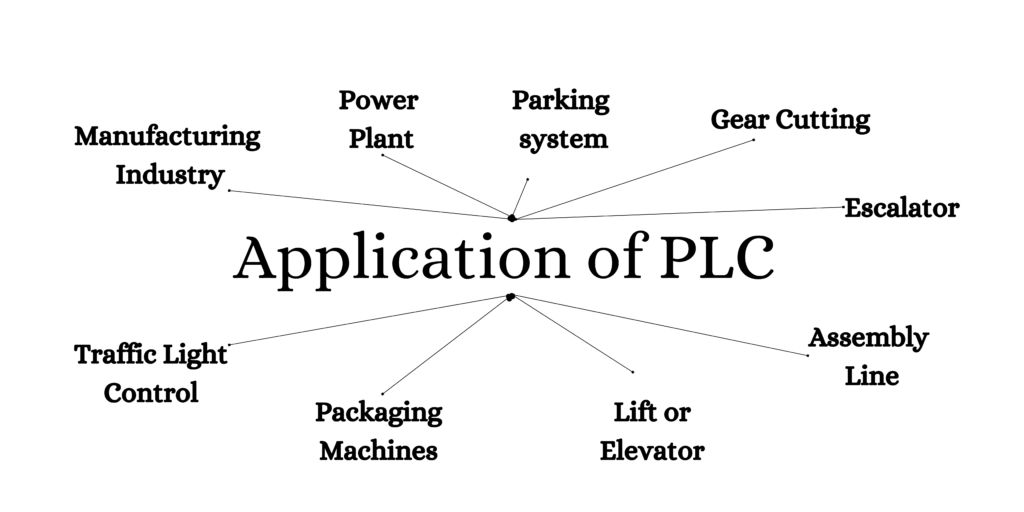Applications of PLC (Programmable Logic Controller)
It’s necessary to have a good understanding of PLCs before diving into their applications. PLCs are designed to automate manual processes without requiring human intervention. They are entirely controlled by actuators, which are managed by the PLC. In this blog post, we’ll explore several Applications of PLC.

If you want to learn more about Programmable Logic Controller (PLC), you can click here.
1. Manufacturing Industry
PLCs are a cornerstone of automation in the manufacturing industry, providing the intelligence and control needed to enhance efficiency, precision, and safety in various processes.
- Material Handling: In manufacturing facilities, PLCs control material handling systems, such as conveyor belts, robotics arms, and automated guided vehicles (AGVs). They manage the movement and positioning of raw materials, work pieces, and finished products.
- Safety Systems: PLCs play a crucial role in implementing safety systems within manufacturing environments. They control emergency stop functions, monitor safety sensors, and ensure compliance with safety standards.
2. Power Plant
An another Application of PLC (Programmable Logic Controller), are widely used in power plants for Automation and control Purposes. The use of PLCs in power plants enhances automation, improves efficiency, and ensures the safety and reliability of operations.
- Cooling Systems Control: Power plants often use complex cooling systems, and PLCs help control the pumps, fans, and other components to maintain optimal temperatures.
- Boiler Control: PLCs are used to control the combustion process in boilers, ensuring efficient and safe operation. They manage parameters such as fuel flow, air flow, and water level.
- Turbine Control: PLCs are involved in controlling the speed, load, and other parameters of turbines to optimize power generation.
There are many other areas in Power Plant where PLC is used above are few of them.
3. Parking System
PLCs are commonly used in parking systems to automate and control various aspects of the parking facility.
- Gate Control: PLCs are used to control the opening and closing of entry and exit gates. They manage access control by validating tickets, RFID cards, or other forms of identification.
- Sensor Integration: PLCs interface with sensors, such as loop detectors or ultrasonic sensors, to detect the presence of vehicles in parking spaces. This information is crucial for managing parking availability and guiding drivers to open spots.
4. Gear Cutting
The use of PLCs in gear cutting not only improves precision and efficiency but also allows for flexibility in adapting to different gear specifications and production requirements.
- Tool Selection and Change: PLCs can be programmed to control the automatic selection and changing of cutting tools based on the gear specifications and the machining requirements.
- Automation of Loading and Unloading: PLCs can be used to automate the loading and unloading of work pieces onto and from the gear cutting machine, improving overall efficiency.
5. Traffic Light Control
PLCs in traffic light control systems contribute to efficient traffic management, improved safety, and reduced congestion by coordinating the operation of traffic signals based on programmed sequences and real-time data.
- Traffic Signal Sequencing: PLCs are responsible for controlling the sequencing of traffic signals at intersections. They determine when each signal green, yellow, and red should be displayed based on the traffic flow patterns and programmed timing sequences.
- Traffic Data Collection: Some traffic light control systems use PLCs to collect data on traffic patterns and signal utilization. This data can be valuable for traffic planning and optimization.
6. Packing Machines
- Batching and Counting: For machines that package products in batches or specific quantities, PLCs manage the batching and counting process to meet production requirements.
- Motion Control: PLCs control the movement of various components in the packing machine, such as conveyors, robotic arms, and sealing mechanisms. They ensure precise and synchronized motion for efficient packaging.
7. Lift or Elevator
The use of PLCs in lifts enhances safety, reliability, and efficiency. They allow for customization of lift behaviour, integration with building management systems, and the implementation of advanced features for user convenience.
- Door Control: PLCs control the opening and closing of lift doors. They manage the timing, sequencing, and safety interlocks to ensure safe entry and exit of passengers.
- Floor Selection and Positioning: PLCs are responsible for interpreting user input, selecting the desired floor, and accurately positioning the lift at the designated floor level.
8. Escalator
PLCs are typically used in escalators to control and coordinate various functions.
- Brake Control: PLCs control the braking system to stop the escalator safely when necessary. This is important for emergency situations or during maintenance.
- Start-Up and Shutdown Sequences: The PLC is responsible for the proper start-up and shutdown procedures, ensuring a gradual acceleration and deceleration of the escalator.
9. Assembly Line
PLCs are widely used in assembly lines for their ability to automate and control various processes.
- Automated Guided Vehicles (AGVs): PLCs are involved in the control of AGVs that transport materials and products between different stations on the assembly line. They coordinate the movement and navigation of AGVs.
- Conveyor Systems: PLCs control the speed, direction, and operation of conveyor belts in assembly lines. They ensure that materials and components move smoothly and efficiently through different stages of the assembly process.
This is all about Applications of PLC. Programmable Logic Controllers (PLCs) are indispensable in industrial automation, enabling efficient, reliable, and safe control of diverse processes across industries. Their versatility and robustness make them a cornerstone of modern industrial processes, and as technology advances, their applications are only set to grow. As industries increasingly adopt automation to boost precision and efficiency, PLCs will continue to play a pivotal role in industrial control systems.
One thought on “Applications of PLC (Programmable Logic Controller)”
Comments are closed.